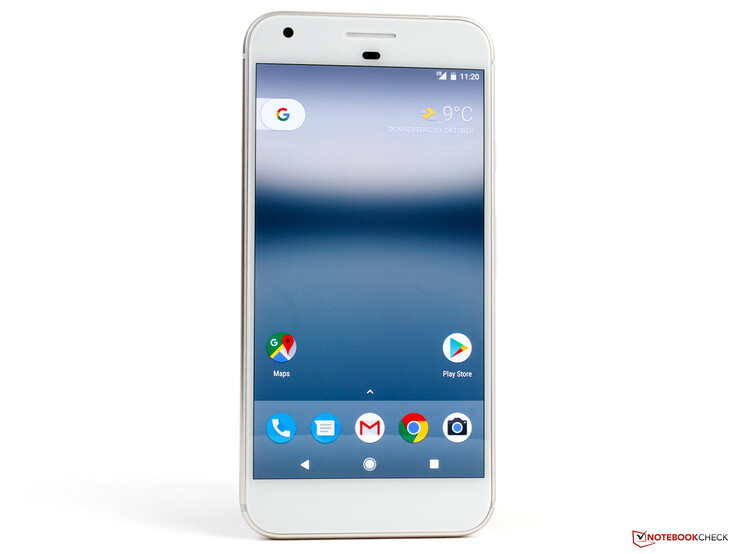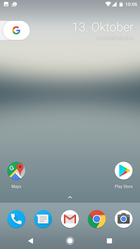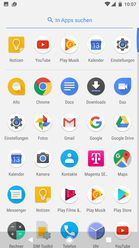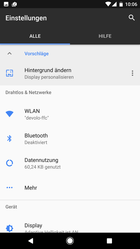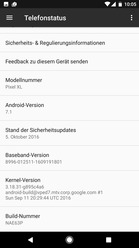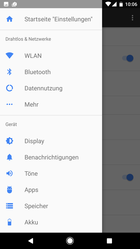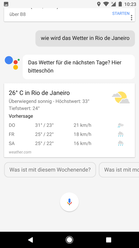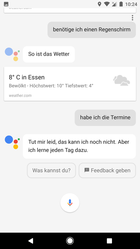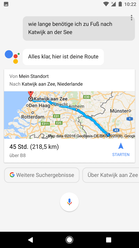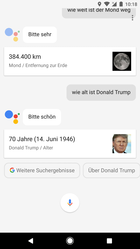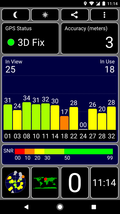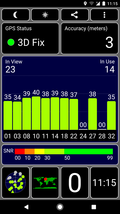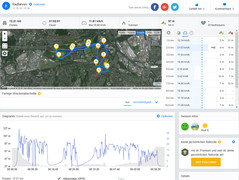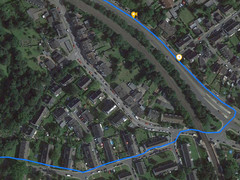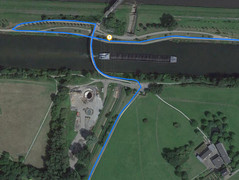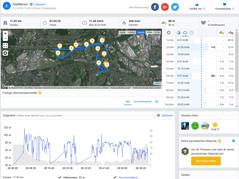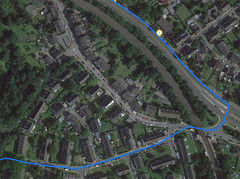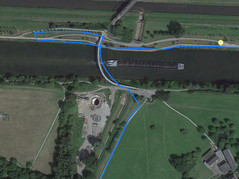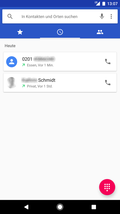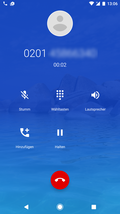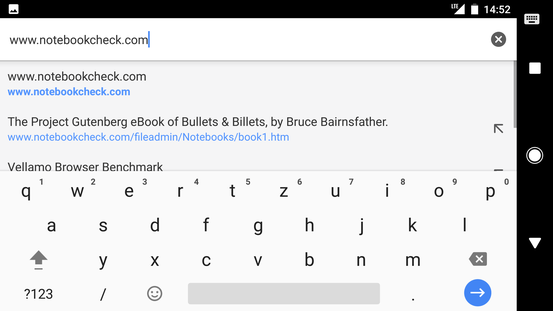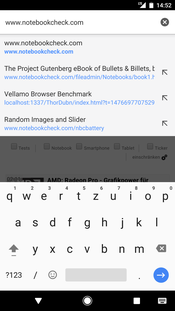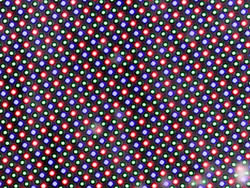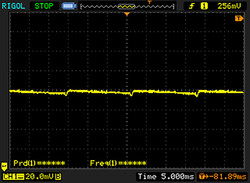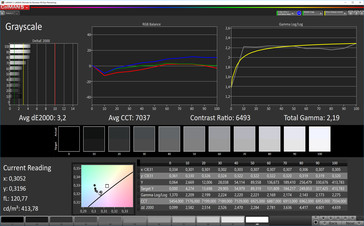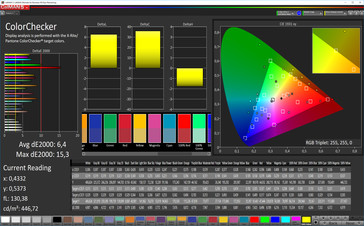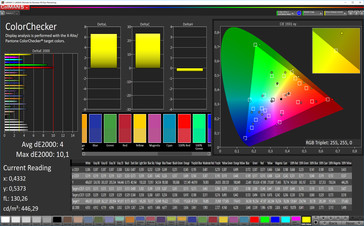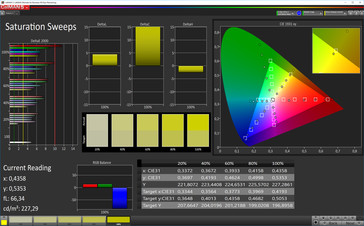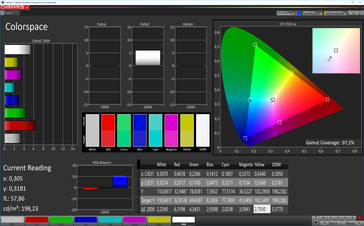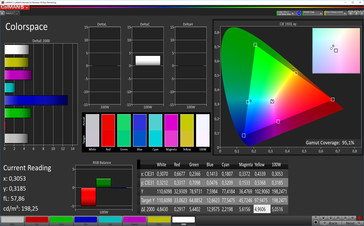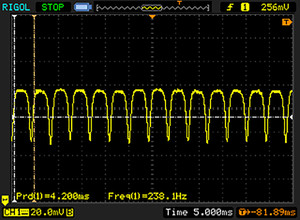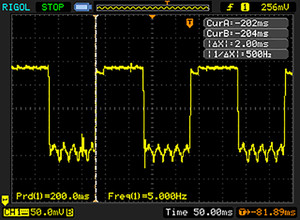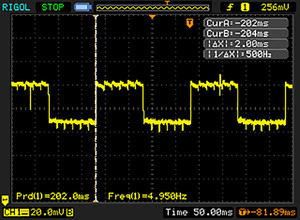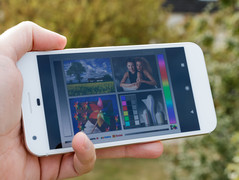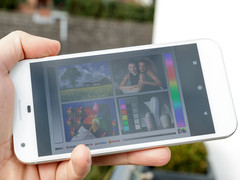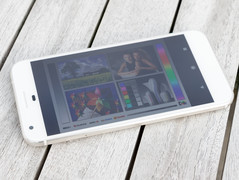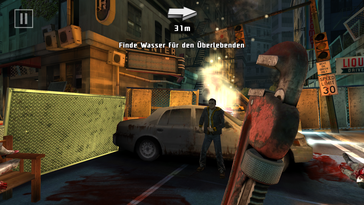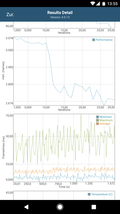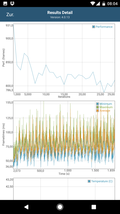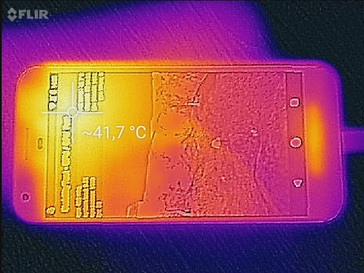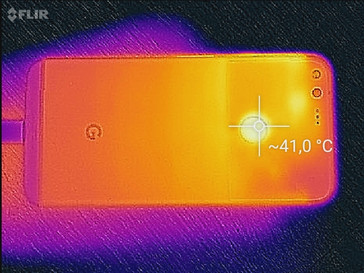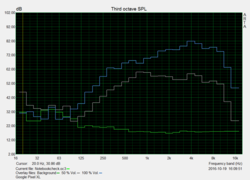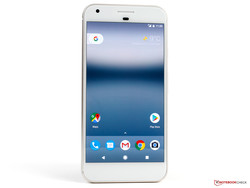Google Pixel XL Smartphone Review
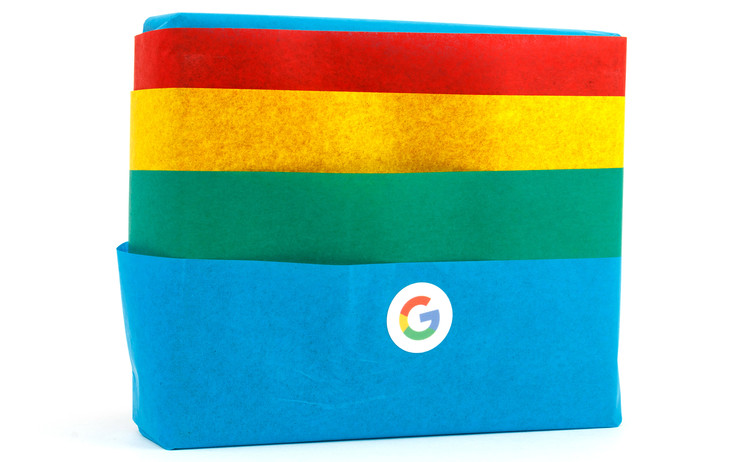
For the original German review, see here.
Google makes a clear statement with the Pixel and Pixel XL and ultimately leaves the segment of affordable smartphones. The smartphones are available from 759 Euros (~$846) and only differ in display diagonal (5.0 and 5.5 inch) as well as storage capacity (32 or 128 GB). Anyone needing a larger panel will have to spend 899 Euros (~$1002). This variant can cost as much as 1009 Euros (~$1125) with the large storage device. Our test model comes with the smaller storage capacity.
The hardware is high-end. Apart from the brand new Snapdragon 821, there is - suitable for its class - 4 GB of RAM. The camera is supposed to be particularly light-sensitive and produce great recordings. In addition, the Pixel XL features a 3450 mAh battery (Pixel: 2700 mAh).
However, is this sufficient to stand up against powerful and significantly cheaper competitors such as the Samsung Galaxy S7 Edge, the Apple iPhone 7 Plus, the Huawei P9 Plus, the HTC 10, the LG G5, the OnePlus 3, or even the Microsoft Lumia 950 XL? We will clarify these in this live review, which we will expand gradually.
Case
The first impression is slightly overwhelming when you hold the Google Pixel XL in your hand. The smartphone appears huge and is only slightly smaller than the iPhone 7 Plus. The design resembles that of the HTC 10. However, the edges are slightly more rounded and not that clear-cut. Both Pixel models are available in silver or anthracite. The display-surface ratio is decent with about 71.2%, but several competitors perform significantly better. For example the Galaxy S7 Edge achieves 76.1%.
The case consists of an aluminum body, which appears to be very high-end and stable. One half of the rear is made of glass. This questionable design is supposed to ensure the best possible antenna reception. On a positive note, the camera is flush with the case.
Gaps are small and even in the Pixel XL and nothing to complain about. In addition, the smartphone is quite unsusceptible to twisting and it is not possible to provoke creaking. Since an AMOLED display is used, it will not show any image distortions.
The battery is fixed and the single slot in the case only takes a nano SIM card. Fortunately, the carriage is made of metal and is quite flush with the case. In addition, thanks to an IP53 certification, the device offers some protection against exposure to moisture and dust. However, you should not expect too much from this: In terms of water resistance, this only means that the Pixel XL will survive rain. Anyone submerging the smartphone in the water will risk destroying it.
Connectivity
The first thing that is disappointing is that a microSD card slot is missing. Thus, you should consider carefully if the smaller variant's 32 GB flash memory is sufficient for your requirements. However, Google has added a special feature to the Pixel XL in order to make the choice easier for photo and video enthusiasts: Recordings can be automatically saved in Google Drive. This keeps only the current photos on the device and the rest is moved to the Cloud without any capacity limit.
The USB port integrated in the Google Pixel XL has the newer Type-C format and uses the USB 3.1 (Gen. 1) standard. While it lacks a display out functionality, it supports OTG, which allows connecting peripherals and external storage devices to the smartphone. AndroidBeam or Miracast can be used for wireless image transmission.
In addition, a Bluetooth V4.2 module and NFC are on board. But unfortunately, the phone lacks a radio receiver and an IR blaster.
While a notification LED is incorporated, it can only be enabled or disabled and does not allow further configuration.
Software
The Google Pixel XL is the first smartphone with the current Google Android 7.1 Nougat operating system. The manufacturer has already provided a statement regarding updates. The current Pixel devices are supposed to be provided with the latest version for two years and with security updates for yet another year.
In general, Version 7.1 differs from Android 7.0 only in details. The biggest feature of the Pixel XL is the new voice assistant called Google Assistant, which is supposed to be also available in German at launch time, even if it will be slightly scaled-off compared to the English variant. For example, language searches in the own gallery are not yet possible in German and the Daily Briefing function, in which the Assistant informs you about the weather, dates, and messages, is only available in English so far. In addition, the German version often responds to queries by opening the search engine instead of giving a direct response. Simple queries about the distance or duration of a trip are usually answered quickly. In addition, queries about weather and making calls work well in practice. So far, the Google Assistant appears to be an improvement of the already existing voice control and cannot fully keep up with Apple's Siri in everyday life, since so far, it lacks control of smart home products.
Communication and GPS
The Google Pixel XL is well equipped for mobile data connections. Apart from quad band GSM and eleven 3G bands, it supports as many as 21 LTE bands. The manufacturer has not cut down on the maximum possible performance and delivers modern LTE Cat. 11 (max. downstream: 600 MBit/s, max. upstream: 75 MBit/s). Even if such a fast internet is not available in Europe so far, the Pixel XL is future-proof and you do not have to be concerned about whether it is possible to connect to the mobile data network abroad. During our time with the smartphone, it worked flawlessly and used almost always the fast LTE connection. The only feature we would like to see is dual SIM support.
Furthermore, Google has not cut down on WLAN and has equipped the Pixel XL with an up-to-date module, which is capable of the IEEE 802.11 standards a/b/g/n/ac and MIMO technology. The high range and the stability of the Wi-Fi are convincing and the transfer rates when connected to our reference router Linksys EA8500 is better than all Android competitors and are only beaten by the iPhone 7.
| Networking | |
| iperf3 transmit AX12 | |
| Apple iPhone 7 (Klaus I211) | |
| Google Pixel XL 2016 | |
| Samsung Galaxy S7 Edge | |
| LG G5 | |
| iperf3 receive AX12 | |
| Apple iPhone 7 (Klaus I211) | |
| Google Pixel XL 2016 | |
| Samsung Galaxy S7 Edge | |
| LG G5 | |
The manufacturer gives little information concerning the satellite networks which can be used from the Google Pixel XL and only mentions the American GPS. However, we could also use the GLONASS network with the App GPS test and the integrated Qualcomm chip is also supposed to be able to use BeiDou and Galileo. Positioning is very fast and accurate both inside buildings and outdoors.
For better evaluation of the positioning we took the Pixel XL with us on a small bike tour. At the beginning of the ride, the smartphone performs even better than the bike computer Garmin Edge 500, but this changes later on. The deviations from the professional navigation device are particularly high around the canal bridge. Overall, the deviations are about 2.3%, which is still a decent result and absolutely sufficient for everyday navigation.
Telephone and Call Quality
The voice quality of the Google Pixel XL is very good when it is held directly to the ear. Speech was transmitted clearly and free of any audible interference on both sides. Thanks to three microphones, noise filtering works well.
However, when the speaker is used, the sound is slightly tiny and resonates. Several other devices perform better in this respect. The speaker is useful in quiet environments and also works acceptably when the phone sits on a table. However, noise reduction is not used in this mode.
The phone app is functional and does not differ much from the predecessors.
Cameras
The front camera of the Google Pixel XL features a resolution of up to 8 MP (3264x2448 pixels) and an f/2.4 aperture. The latter sounds as if the camera would not be particularly light sensitive, but a pixel size of 1.4 µm makes up for this. Unfortunately, the camera features only fixed focus. Nevertheless, it shoots relatively good pictures and even indoor shots are not too noisy. Videos can be recorded in Full HD resolution.
The primary camera has a resolution of 12.3 MP and features both laser and phase-detection auto-focus. With a pixel size of 1.55 µm and an f/2.0 aperture, Google directly attacks the currently best smartphone camera from Samsung and the Pixel XL actually comes close to the modules of the S7 series. Daylight shots have a high dynamic range and thanks to a good automatic HDR, the camera even performs excellently when shooting against the light. The color reproduction is quite balanced and images even remain sharp and detail-rich in poor lighting conditions. The Pixel XL reached a better image quality than the Galaxy S7 in scene 1 and 2. However, the advantage is very small and non-existent in low-light shooting. Furthermore, the Galaxy S7 has a faster shutter speed than the Pixel XL especially when taking pictures of moving objects.
The Pixel XL records videos in Ultra HD (3840x2160 pixels, 30 fps). The quality is good. However, fast pans result in image errors, which become apparent at closer inspection. In addition, darker areas tend to show blocking artifacts. Moreover, the image stabilization is less efficient than that of the S7's.
Accessories and Warranty
The Google Pixel XL includes a modular power adapter rated at up to 18 watts (5 Volt, 3.0 Ampere or 9 Volt, 2.0 Ampere), two USB cables (Type-C to Typ-C and Type-C to Type-A), an OTG adapter, and a small SIM tool. Several optional cases are available for this smartphone.
The manufacturer offers a 24-months warranty for this product. Please see our Guarantees, Return Policies & Warranties FAQ for country-specific information.
Input Devices and Handling
The capacitive touchscreen of the Google Pixel XL recognizes up to 10 simultaneous inputs and the surface, which is protected by Corning Gorilla Glass 4, has very good gliding traits. The touchscreen responds quickly and reliably regardless of where you touch it.
Voice recognition for the Google Assistant also works very well with only few misunderstandings; even at a slightly further distance to the phone.
The physical buttons feature a distinct and precise pressure point, sit firmly in the case and appear to work flawlessly. It is not surprising that Google uses its own keyboard layout. Those who do not like it can download other layouts from the Play Store.
Display
The Google Pixel XL uses a 5.5-inch AMOLED display with a resolution of 2560x1440 pixels for a razor-sharp image. The brightness is decent with an average of 408 cd/m². Even more so as the more real-world scenario with equal distribution of bright and dark image parts (APL50) gives up to 518 cd/m². Unlike the Galaxy S7, the brightness does not improve when the brightness sensor is enabled. Due to the panel technology, the contrast is unbeatable and infinite in theory.
As usual for OLED screens, the Pixel XL also uses PWM for dimming. Although PWM can still be detected at maximum brightness, it is not so severe thanks to a flat gradient (60 Hz). Flickering first becomes visible to sensitive eyes at a brightness level below 23%.
| |||||||||||||||||||||||||
Brightness Distribution: 85 %
Center on Battery: 402 cd/m²
Contrast: ∞:1 (Black: 0 cd/m²)
ΔE ColorChecker Calman: 4 | ∀{0.5-29.43 Ø4.78}
ΔE Greyscale Calman: 3.2 | ∀{0.09-98 Ø5}
Gamma: 2.19
CCT: 7037 K
| Google Pixel XL 2016 AMOLED, 2560x1440, 5.5" | Google Nexus 6P AMOLED, 2560x1440, 5.7" | Apple iPhone 7 Plus IPS, 1920x1080, 5.5" | Samsung Galaxy S7 Edge Super AMOLED, 2560x1440, 5.5" | Huawei P9 Plus AMOLED, 1920x1080, 5.5" | Microsoft Lumia 950 XL AMOLED, 2560x1440, 5.7" | HTC 10 Super LCD 5, 2560x1440, 5.2" | |
|---|---|---|---|---|---|---|---|
| Screen | 19% | 47% | 43% | -20% | 10% | 14% | |
| Brightness middle (cd/m²) | 402 | 363 -10% | 557 39% | 554 38% | 361 -10% | 297 -26% | 445 11% |
| Brightness (cd/m²) | 408 | 365 -11% | 553 36% | 552 35% | 366 -10% | 297 -27% | 434 6% |
| Brightness Distribution (%) | 85 | 90 6% | 97 14% | 96 13% | 87 2% | 93 9% | 93 9% |
| Black Level * (cd/m²) | 0.35 | 0.36 | |||||
| Colorchecker dE 2000 * | 4 | 2.34 41% | 1.4 65% | 1.59 60% | 5.1 -28% | 2.67 33% | 2.8 30% |
| Colorchecker dE 2000 max. * | 10.1 | 3.1 69% | 2.56 75% | 10 1% | 3.98 61% | 5.8 43% | |
| Greyscale dE 2000 * | 3.2 | 1.03 68% | 1.3 59% | 2.01 37% | 5.5 -72% | 2.81 12% | 3.7 -16% |
| Gamma | 2.19 100% | 2.23 99% | 2.21 100% | 2.01 109% | 2.24 98% | 2.08 106% | 2.31 95% |
| CCT | 7037 92% | 6429 101% | 6667 97% | 6321 103% | 7388 88% | 6379 102% | 7164 91% |
| Contrast (:1) | 1591 | 1236 | |||||
| Color Space (Percent of AdobeRGB 1998) (%) | 63.1 | 82.12 | 66.31 | ||||
| Color Space (Percent of sRGB) (%) | 99.83 | 99.98 | 99.79 |
* ... smaller is better
Subjectivity, the color reproduction of the Google Pixel XL appears great with deep contrasts. Nevertheless, we used the CalMAN analysis software and the photospectrometer to check it. While the results are good, other high-end competitors deliver better colors. Only the Huawei P9 Plus performs worse in this respect. The ColorChecker even reveals significant deviations for green and red with dE 8 and dE 10, respectively. However, as expected, the gamut is high.
Unfortunately, the settings of the Pixel do not offer options for adjusting the image quality.
Screen Flickering / PWM (Pulse-Width Modulation)
| Screen flickering / PWM detected | 238.1 Hz | ||
The display backlight flickers at 238.1 Hz (worst case, e.g., utilizing PWM) . The frequency of 238.1 Hz is relatively low, so sensitive users will likely notice flickering and experience eyestrain at the stated brightness setting and below. In comparison: 53 % of all tested devices do not use PWM to dim the display. If PWM was detected, an average of 8111 (minimum: 5 - maximum: 343500) Hz was measured. | |||
Display Response Times
| ↔ Response Time Black to White | ||
|---|---|---|
| 4 ms ... rise ↗ and fall ↘ combined | ↗ 2 ms rise | |
| ↘ 2 ms fall | ||
| The screen shows very fast response rates in our tests and should be very well suited for fast-paced gaming. In comparison, all tested devices range from 0.1 (minimum) to 240 (maximum) ms. » 15 % of all devices are better. This means that the measured response time is better than the average of all tested devices (20.2 ms). | ||
| ↔ Response Time 50% Grey to 80% Grey | ||
| 4 ms ... rise ↗ and fall ↘ combined | ↗ 2 ms rise | |
| ↘ 2 ms fall | ||
| The screen shows very fast response rates in our tests and should be very well suited for fast-paced gaming. In comparison, all tested devices range from 0.165 (minimum) to 636 (maximum) ms. » 14 % of all devices are better. This means that the measured response time is better than the average of all tested devices (31.6 ms). | ||
The Google Pixel XL performs well in outdoor use due to its high contrast and brightness. The display content remains legible in the autumn sun, even though a shady place is recommended for prolonged reading. Furthermore, reflections can have adverse effects on the legibility.
The viewing angles of the Google Pixel XL are very good. In view of the AMOLED technology this was to be expected. Even at very flat angles, there is almost no brightness loss, although you can see a slight glimmer on the panel, which, however, is not disturbing in everyday use.
Performance
The Google Pixel XL is the first smartphone that uses a Qualcomm Snapdragon 821 MSM8996 Pro. This is a slightly higher clocked variant of the Snapdragon 820. Instead of 2.15 GHz, the cores of the performance cluster can now clock at up to 2.4 GHz. However, the power-saving cluster has remained unchanged with a maximum of 1.6 GHz. The integrated Adreno 530 also clocks higher at up to 653 MHz. However, the Pixel XL test model comes with a CPU which is limited to 2.15 GHz. Hence, the SoC is hardly faster than a conventional Snapdragon 820. This is reflected by the benchmarks.
While the CPU benchmarks are on par with the Snapdragon 820's, the test model performs slightly better in the graphic benchmarks because of its higher GPU clock. The smartphone achieves good results in the system benchmarks, which confirm the subjective experience of a smooth system. The Pixel XL falls only slightly behind the expectations in PCMark for Android and ranks in just before the Galaxy S7.
| AnTuTu v6 - Total Score (sort by value) | |
| Google Pixel XL 2016 | |
| HTC 10 | |
| OnePlus 3 | |
| Apple iPhone 7 Plus | |
| Samsung Galaxy S7 Edge | |
| Lenovo Moto Z | |
| Microsoft Lumia 950 XL | |
| Huawei P9 | |
| Lenovo ZUK Z2 | |
| LG G5 | |
| Geekbench 4.0 | |
| 64 Bit Single-Core Score (sort by value) | |
| Google Pixel XL 2016 | |
| OnePlus 3 | |
| Apple iPhone 7 Plus | |
| Samsung Galaxy S7 Edge | |
| Lenovo Moto Z | |
| Huawei P9 | |
| LG G5 | |
| 64 Bit Multi-Core Score (sort by value) | |
| Google Pixel XL 2016 | |
| OnePlus 3 | |
| Apple iPhone 7 Plus | |
| Samsung Galaxy S7 Edge | |
| Lenovo Moto Z | |
| Huawei P9 | |
| LG G5 | |
| 3DMark | |
| 2560x1440 Sling Shot OpenGL ES 3.0 Unlimited (sort by value) | |
| Google Pixel XL 2016 | |
| OnePlus 3 | |
| Apple iPhone 7 Plus | |
| Samsung Galaxy S7 Edge | |
| Lenovo Moto Z | |
| Lenovo ZUK Z2 | |
| LG G5 | |
| 2560x1440 Sling Shot OpenGL ES 3.0 Unlimited Graphics (sort by value) | |
| Google Pixel XL 2016 | |
| OnePlus 3 | |
| Apple iPhone 7 Plus | |
| Samsung Galaxy S7 Edge | |
| Lenovo Moto Z | |
| Lenovo ZUK Z2 | |
| LG G5 | |
| 2560x1440 Sling Shot OpenGL ES 3.0 Unlimited Physics (sort by value) | |
| Google Pixel XL 2016 | |
| OnePlus 3 | |
| Apple iPhone 7 Plus | |
| Samsung Galaxy S7 Edge | |
| Lenovo Moto Z | |
| Lenovo ZUK Z2 | |
| LG G5 | |
| 2560x1440 Sling Shot Extreme (ES 3.1) Unlimited (sort by value) | |
| Google Pixel XL 2016 | |
| OnePlus 3 | |
| Samsung Galaxy S7 Edge | |
| Lenovo Moto Z | |
| Lenovo ZUK Z2 | |
| LG G5 | |
| 2560x1440 Sling Shot Extreme (ES 3.1) Unlimited Graphics (sort by value) | |
| Google Pixel XL 2016 | |
| OnePlus 3 | |
| Samsung Galaxy S7 Edge | |
| Lenovo Moto Z | |
| Lenovo ZUK Z2 | |
| LG G5 | |
| 2560x1440 Sling Shot Extreme (ES 3.1) Unlimited Physics (sort by value) | |
| Google Pixel XL 2016 | |
| OnePlus 3 | |
| Samsung Galaxy S7 Edge | |
| Lenovo Moto Z | |
| Lenovo ZUK Z2 | |
| LG G5 | |
| GFXBench 3.0 | |
| on screen Manhattan Onscreen OGL (sort by value) | |
| Google Pixel XL 2016 | |
| HTC 10 | |
| OnePlus 3 | |
| Apple iPhone 7 Plus | |
| Samsung Galaxy S7 Edge | |
| Lenovo Moto Z | |
| Microsoft Lumia 950 XL | |
| Huawei P9 | |
| Lenovo ZUK Z2 | |
| LG G5 | |
| 1920x1080 1080p Manhattan Offscreen (sort by value) | |
| Google Pixel XL 2016 | |
| HTC 10 | |
| OnePlus 3 | |
| Apple iPhone 7 Plus | |
| Samsung Galaxy S7 Edge | |
| Lenovo Moto Z | |
| Microsoft Lumia 950 XL | |
| Huawei P9 | |
| Lenovo ZUK Z2 | |
| LG G5 | |
| GFXBench 3.1 | |
| on screen Manhattan ES 3.1 Onscreen (sort by value) | |
| Google Pixel XL 2016 | |
| HTC 10 | |
| OnePlus 3 | |
| Apple iPhone 7 Plus | |
| Samsung Galaxy S7 Edge | |
| Lenovo Moto Z | |
| Huawei P9 | |
| Lenovo ZUK Z2 | |
| LG G5 | |
| 1920x1080 Manhattan ES 3.1 Offscreen (sort by value) | |
| Google Pixel XL 2016 | |
| HTC 10 | |
| OnePlus 3 | |
| Apple iPhone 7 Plus | |
| Samsung Galaxy S7 Edge | |
| Lenovo Moto Z | |
| Huawei P9 | |
| Lenovo ZUK Z2 | |
| LG G5 | |
| PCMark for Android - Work performance score (sort by value) | |
| Google Pixel XL 2016 | |
| HTC 10 | |
| OnePlus 3 | |
| Samsung Galaxy S7 Edge | |
| Lenovo Moto Z | |
| Huawei P9 | |
| Lenovo ZUK Z2 | |
| LG G5 | |
| Basemark ES 3.1 / Metal - offscreen Overall Score (sort by value) | |
| Google Pixel XL 2016 | |
| HTC 10 | |
| OnePlus 3 | |
| Apple iPhone 7 Plus | |
| Samsung Galaxy S7 Edge | |
| Lenovo Moto Z | |
| Huawei P9 | |
| LG G5 | |
| Lightmark - 1920x1080 1080p (sort by value) | |
| OnePlus 3 | |
| Samsung Galaxy S7 Edge | |
| Lenovo Moto Z | |
| Huawei P9 | |
| LG G5 | |
| Epic Citadel - Ultra High Quality (sort by value) | |
| Google Pixel XL 2016 | |
| OnePlus 3 | |
| Samsung Galaxy S7 Edge | |
| Lenovo Moto Z | |
| Huawei P9 | |
| LG G5 | |
In the browser benchmarks with the Chrome 53, the Google Pixel XL ranks in mid-range among the comparison devices. Subjectively, the smartphone performs very fast in web surfing without any major delays.
| Octane V2 - Total Score (sort by value) | |
| Google Pixel XL 2016 | |
| HTC 10 | |
| OnePlus 3 | |
| Apple iPhone 7 Plus | |
| Samsung Galaxy S7 Edge | |
| Lenovo Moto Z | |
| Microsoft Lumia 950 XL | |
| Huawei P9 | |
| Lenovo ZUK Z2 | |
| LG G5 | |
| Mozilla Kraken 1.1 - Total (sort by value) | |
| Google Pixel XL 2016 | |
| HTC 10 | |
| OnePlus 3 | |
| Apple iPhone 7 Plus | |
| Samsung Galaxy S7 Edge | |
| Lenovo Moto Z | |
| Microsoft Lumia 950 XL | |
| Huawei P9 | |
| Lenovo ZUK Z2 | |
| LG G5 | |
| WebXPRT 2015 - Overall (sort by value) | |
| Google Pixel XL 2016 | |
| HTC 10 | |
| OnePlus 3 | |
| Apple iPhone 7 Plus | |
| Samsung Galaxy S7 Edge | |
| Lenovo Moto Z | |
| Microsoft Lumia 950 XL | |
| Huawei P9 | |
| LG G5 | |
| JetStream 1.1 - Total Score (sort by value) | |
| Google Pixel XL 2016 | |
| HTC 10 | |
| OnePlus 3 | |
| Apple iPhone 7 Plus | |
| Samsung Galaxy S7 Edge | |
| Lenovo Moto Z | |
| Microsoft Lumia 950 XL | |
| Huawei P9 | |
| Lenovo ZUK Z2 | |
| LG G5 | |
* ... smaller is better
Our test model features 32 GB internal storage. The manufacturer also offers a 128 GB variant of the Google Pixel XL. Unfortunately, the performance of the storage device is not high-end, but mid-range at best. The Pixel does not stand a chance against devices with fast UFS storage.
| Google Pixel XL 2016 Adreno 530, SD 821, 32 GB eMMC Flash | HTC 10 Adreno 530, 820 MSM8996, 32 GB eMMC Flash | OnePlus 3 Adreno 530, 820 MSM8996, 64 GB UFS 2.0 Flash | Samsung Galaxy S7 Edge Mali-T880 MP12, Exynos 8890, 32 GB UFS 2.0 Flash | Lenovo Moto Z Adreno 530, 820 MSM8996, 32 GB eMMC Flash | Huawei P9 Mali-T880 MP4, Kirin 955, 32 GB eMMC Flash | Lenovo ZUK Z2 Adreno 530, 820 MSM8996, 64 GB eMMC Flash | LG G5 Adreno 530, 820 MSM8996, 32 GB eMMC Flash | |
|---|---|---|---|---|---|---|---|---|
| AndroBench 3-5 | -3% | 56% | 43% | 155% | 42% | -47% | 37% | |
| Sequential Read 256KB (MB/s) | 258.2 | 275.1 7% | 408.7 58% | 487.3 89% | 439.7 70% | 281.3 9% | 239.4 -7% | 427.6 66% |
| Sequential Write 256KB (MB/s) | 83.4 | 115.6 39% | 153.3 84% | 145.1 74% | 168.3 102% | 72.2 -13% | 46.52 -44% | 141.3 69% |
| Random Read 4KB (MB/s) | 87.7 | 29.92 -66% | 137.6 57% | 86.7 -1% | 117.2 34% | 39 -56% | 21.27 -76% | 89.3 2% |
| Random Write 4KB (MB/s) | 14.56 | 15.89 9% | 18.23 25% | 15.79 8% | 74.9 414% | 47.45 226% | 5.64 -61% | 16.22 11% |
Games
Currently, the Adreno 530 in the Google Pixel XL is one of the fastest GPUs that can be incorporated into smartphones and tablets. Despite a high-resolution display, it can run all games from the Play Store without any problems. Sensors and touchscreen also work flawlessly. Hence you can enjoy gaming to the fullest. We would only wish for slightly shorter loading times, which might be longer because of the slower storage device. In addition, it is easy to cover the speakers when using the smartphone in landscape format.
| Asphalt 8: Airborne | |||
| Settings | Value | ||
| high | 30 fps | ||
| very low | 30 fps | ||
| Dead Trigger 2 | |||
| Settings | Value | ||
| high | 58 fps | ||
Emissions
Temperature
While idling, the surface temperatures of the Google Pixel XL are exemplary and only exceed the 30 °C (~86 °F) level in a few spots. Under load, the temperature increases to up to 42.3 °C (~108 °F) on the front side. While this is quite warm, it is not critical at all.
A strong chipset works inside. Hence, it is all the more important to check whether it can constantly deliver its full performance under prolonged load. For this, we run the battery test of the GFXBench, one of the most popular graphic benchmarks, 30 times in a row and record battery state as well as frame rates. In the slightly lighter OpenGL ES 2.0 test (T-Rex), the performance falls noticeably after 10 runs and even falls by up to 14% later on. In the demanding Manhattan test (OpenGL ES 3.1), the performance falls significantly after the first run and finally reaches a minimum of about 85% of the initial performance.
(±) The maximum temperature on the upper side is 42.3 °C / 108 F, compared to the average of 35.2 °C / 95 F, ranging from 21.9 to 247 °C for the class Smartphone.
(+) The bottom heats up to a maximum of 38.5 °C / 101 F, compared to the average of 34 °C / 93 F
(+) In idle usage, the average temperature for the upper side is 29.5 °C / 85 F, compared to the device average of 32.9 °C / 91 F.
Speakers
The mono speaker on the lower edge of the Google Pixel XL delivers an acceptable sound quality. However, we did not expect sound wonders and the speaker is quite sufficient for occasional playback of music and videos. Furthermore, the volume is relatively high with up to 88.5 dB(A). However, the high tones are audibly distorted at maximum volume.
Since there is an audio jack, you can use all usual headphones without problems if you require a better sound quality. Subjectively, the jack provides a low-noise and accurate sound.
Google Pixel XL 2016 audio analysis
(+) | speakers can play relatively loud (88.5 dB)
Bass 100 - 315 Hz
(-) | nearly no bass - on average 21.8% lower than median
(±) | linearity of bass is average (11.2% delta to prev. frequency)
Mids 400 - 2000 Hz
(+) | balanced mids - only 3.5% away from median
(+) | mids are linear (4.3% delta to prev. frequency)
Highs 2 - 16 kHz
(±) | higher highs - on average 8.1% higher than median
(+) | highs are linear (4.2% delta to prev. frequency)
Overall 100 - 16.000 Hz
(±) | linearity of overall sound is average (20.4% difference to median)
Compared to same class
» 34% of all tested devices in this class were better, 9% similar, 57% worse
» The best had a delta of 11%, average was 35%, worst was 134%
Compared to all devices tested
» 53% of all tested devices were better, 8% similar, 39% worse
» The best had a delta of 4%, average was 24%, worst was 134%
Apple iPhone 7 Plus audio analysis
(±) | speaker loudness is average but good (81.4 dB)
Bass 100 - 315 Hz
(-) | nearly no bass - on average 24.1% lower than median
(±) | linearity of bass is average (7.4% delta to prev. frequency)
Mids 400 - 2000 Hz
(+) | balanced mids - only 4.7% away from median
(±) | linearity of mids is average (7.6% delta to prev. frequency)
Highs 2 - 16 kHz
(+) | balanced highs - only 4.3% away from median
(+) | highs are linear (6.9% delta to prev. frequency)
Overall 100 - 16.000 Hz
(±) | linearity of overall sound is average (22% difference to median)
Compared to same class
» 45% of all tested devices in this class were better, 7% similar, 48% worse
» The best had a delta of 11%, average was 35%, worst was 134%
Compared to all devices tested
» 63% of all tested devices were better, 7% similar, 31% worse
» The best had a delta of 4%, average was 24%, worst was 134%
Lenovo Moto Z audio analysis
(+) | speakers can play relatively loud (83.9 dB)
Bass 100 - 315 Hz
(-) | nearly no bass - on average 34.4% lower than median
(±) | linearity of bass is average (8.2% delta to prev. frequency)
Mids 400 - 2000 Hz
(±) | reduced mids - on average 5.4% lower than median
(+) | mids are linear (6% delta to prev. frequency)
Highs 2 - 16 kHz
(+) | balanced highs - only 2.3% away from median
(+) | highs are linear (1.8% delta to prev. frequency)
Overall 100 - 16.000 Hz
(±) | linearity of overall sound is average (23.5% difference to median)
Compared to same class
» 53% of all tested devices in this class were better, 8% similar, 39% worse
» The best had a delta of 11%, average was 35%, worst was 134%
Compared to all devices tested
» 69% of all tested devices were better, 6% similar, 24% worse
» The best had a delta of 4%, average was 24%, worst was 134%
Energy Management
Power Consumption
The power consumption of the Google Pixel XL is very low. None of the competitors in our comparison group can keep up with our test model, which promises good battery runtimes.
The powerful power adapter supports QuickCharge and fully charges the smartphone within 109 minutes. After 15 minutes, it reaches 24% and after 30 minutes it reaches 50% of the battery capacity. The 80% mark is reached in 65 minutes. Wireless charging is not supported.
Google has supplied its device with a power efficient adapter that according to our measurements does not consume energy by itself.
| Off / Standby | |
| Idle | |
| Load |
|
Key:
min: | |
| Google Pixel XL 2016 3450 mAh | Google Nexus 6P 3450 mAh | HTC 10 3000 mAh | Apple iPhone 7 Plus 2915 mAh | Samsung Galaxy S7 Edge 3600 mAh | Huawei P9 Plus 3400 mAh | OnePlus 3 3000 mAh | |
|---|---|---|---|---|---|---|---|
| Power Consumption | -30% | -45% | -52% | -15% | -13% | -24% | |
| Idle Minimum * (Watt) | 0.53 | 0.83 -57% | 0.68 -28% | 0.77 -45% | 0.63 -19% | 0.87 -64% | 0.57 -8% |
| Idle Average * (Watt) | 1.07 | 1.09 -2% | 1.49 -39% | 2.04 -91% | 1.1 -3% | 1.2 -12% | 1.24 -16% |
| Idle Maximum * (Watt) | 1.12 | 1.17 -4% | 1.91 -71% | 2.24 -100% | 1.56 -39% | 1.27 -13% | 1.36 -21% |
| Load Average * (Watt) | 5.53 | 7.49 -35% | 7.4 -34% | 4.69 15% | 5.95 -8% | 4.69 15% | 5.92 -7% |
| Load Maximum * (Watt) | 6.26 | 9.51 -52% | 9.71 -55% | 8.66 -38% | 6.7 -7% | 5.63 10% | 10.53 -68% |
* ... smaller is better
Battery Life
With 3450 mAh, the Google Pixel XL comes with a powerful battery, which should ensure very good battery runtimes. However, some competitors feature batteries with smaller or equal capacity that last significantly longer in our tests.
Tests with an adjusted brightness (150 cd/m²) are most meaningful. During web surfing via WLAN and video playback, the smartphone lasts about 8.5 hours. Only, the HTC 10 and the Nexus 6P last shorter in the Wi-Fi test. In the video test, the Pixel performs even worse in our comparison group.
Nevertheless, the smartphone delivers a very good battery life in everyday use and should last a whole day without problems.
| Google Pixel XL 2016 3450 mAh | Google Nexus 6P 3450 mAh | HTC 10 3000 mAh | Apple iPhone 7 Plus 2915 mAh | Samsung Galaxy S7 Edge 3600 mAh | Huawei P9 Plus 3400 mAh | OnePlus 3 3000 mAh | |
|---|---|---|---|---|---|---|---|
| Battery runtime | 4% | -1% | 29% | 56% | 21% | 38% | |
| Reader / Idle (h) | 22.2 | 24.1 9% | 21.2 -5% | 30.6 38% | 27.7 25% | 24.1 9% | 22.3 0% |
| H.264 (h) | 8.4 | 8.9 6% | 10.8 29% | 13.6 62% | 15.2 81% | 12.9 54% | 14.1 68% |
| WiFi v1.3 (h) | 8.4 | 6.3 -25% | 6.9 -18% | 9.8 17% | 12.2 45% | 8.8 5% | 14 67% |
| Load (h) | 3.8 | 4.7 24% | 3.4 -11% | 3.8 0% | 6.5 71% | 4.4 16% | 4.5 18% |
Pros
Cons
Verdict
The Google Pixel XL is a very good smartphone. However, its core feature, the Google Assistant, is not a decisive reason to buy it. Above all, it does not justify the price which the manufacturer charges for its product.
However, the Pixel XL brings high-end technology with a powerful processor, a high RAM capacity, a great camera, fast Wi-Fi and LTE Cat. 11 as well as an excellent voice quality.
There will be different opinions about the design. However, it is disappointing that the storage capacity cannot be expanded with a microSD card, since the surcharge for the variant with a larger storage capacity is quite steep. The infinite Cloud storage for photos can make up for this only to a certain extent. In addition, the battery runtimes should be slightly improved, which might be possible with a software update, since the used components would suggest a higher potential.
The Google Pixel XL brings top features. Unfortunately, the price also reaches a new record.
The Google Pixel XL is a smartphone for enthusiasts. Customers will decide whether the concept is successful.
Google Pixel XL 2016
- 11/02/2016 v5.1 (old)
Daniel Schmidt




